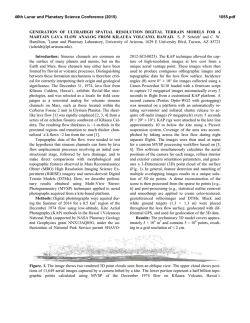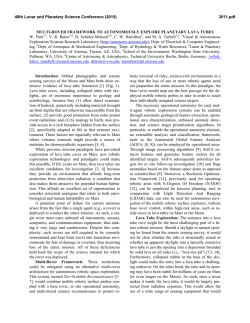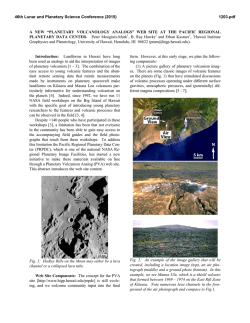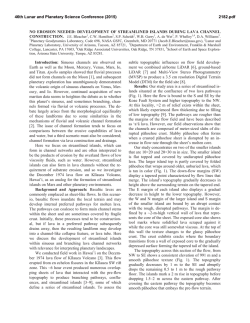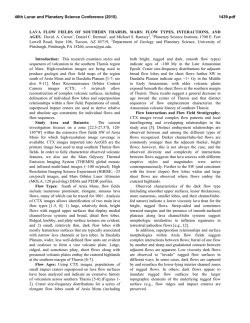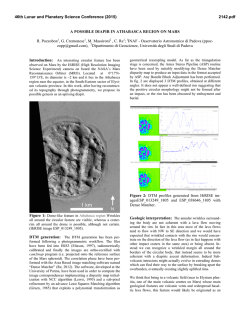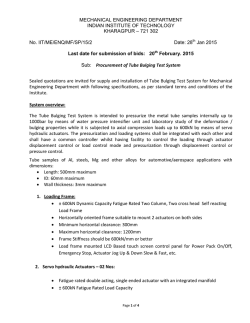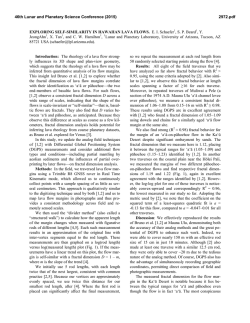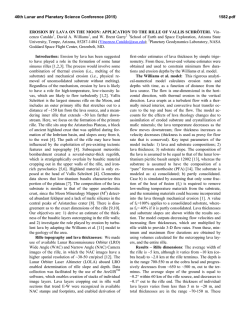
Determining the Structural Stability of Lunar Lava Tubes
46th Lunar and Planetary Science Conference (2015) 2174.pdf DETERMINING THE STRUCTURAL STABILITY OF LUNAR LAVA TUBES. D. M. Blair1*, L. Chappaz2, R. Sood2, C. Milbury1, H. J. Melosh1, K. C. Howell2, and A. M. Freed1. 1,* Department of Earth, Atmospheric, and Planetary Sciences, Purdue University, West Lafayette, IN, USA, [email protected]; 2School of Aeronautics and Astronautics, Purdue University, West Lafayette, IN, USA. Introduction: Recent in-depth analysis of lunar gravity data from the Gravity Recovery And Interior Laboratory (GRAIL) spacecraft has suggested the possibility of lava tubes on the Moon with diameters in excess of 1 km [1, 2]. Could such features be structurally stable? What is the theoretical maximum size of a lunar lava tube? Here we attempt to address those questions and improve on prior estimates of the same by using modern numerical modeling techniques. Background: The presence of sublunarean voids has recently been confirmed via the observation of "skylights" in several lunar maria [3, 4, 5]. These openings have widths of 49–106 m [5], indicating underlying voids of at least that size, though neither the size nor the extent of the underlying cavern can be discerned solely from visual observations. Gravity data, however, can be used to investigate the size of caverns on the Moon in more detail. Using both gravity gradiometry and cross-correlation between the GRAIL gravity field and the calculated gravity signature of theoretical buried empty tubes, it is possible to not only find locations where lava tubes may exist, but also to place constraints on their size. Prior work has shown that the signature produced by a 1–2 km wide empty cylinder beneath the lunar surface correlates positively with GRAIL gravity observations at Schröter Vallis [1, 2]. Near Rima Sharp, forward modeling of a suspected 2 km wide, 75 km long empty lava tube provides a good match to GRAIL observations [2]. The widths of these tubes are much greater than those expected from previous calculations of structurally stable openings under the lunar surface. On Earth, lava tubes are generally less than ~30 m across [6]; lava tubes on the Moon are expected to be wider due to the lower gravity. The structural integrity of a lava tube depends in part on the thickness and width of its roof. Using beam theory to calculate the maximum width of a buried lava tube on the Moon, Oberbeck et al. [7] found that a 385 m wide flat-roofed lava tube buried 65 m under the lunar surface could remain stable, given a basalt density of 2500 kg m-3. They also discussed the possibility of roof widths up to 500 m—the figure most often cited in the literature— but this result is based on a hypothetical vesicular bulk lunar basalt density of only 1500 kg m-3, well below recent re-analyses of Apollo mare samples which give bulk densities of 3010–3270 kg m-3 [8]. Oberbeck et al. [7] also note that an arched roof would allow a wider lava tube or a thinner roof, but do not quantify what difference an arched roof would make. In caves on Earth that occur in bedded rock, failure of the cave’s roof tends to occur one bed at a time, progressing upwards [9]. This means that the mechanical “roof thickness” of a lava tube should be considered to be the thickness of the flows that form the roof and not the total depth at which the tube is buried. Lava flows thicknesses on the moon vary over a broad range, from 1–14 m in the skylights in Mare Tranquilitatis and elsewhere [5] to ~80–600 m in Oceanus Procellarum and Mare Serenitatis [10]. Methods: We calculate the stresses and strains present around a lava tube of a given shape and size using thermo-elastic finite element models built in the Abaqus software suite. Between models, we vary the lava tube’s width, roof shape, and roof thickness, as discussed above. All of our models are carried out in two dimensions, and employ a plane strain assumption. The models are allowed to move freely, except for the bottom edge which is fixed in the vertical direction. Our models account for both thermal and gravitational stresses. The latter is accomplished simply by placing a vertical gravity load on the model appropriate to the lunar surface (1.622 N kg-1). To calculate the stresses caused by cooling, we start with the entire model at an assumed elastic blocking temperature of 1073 K [see 11], and then place a boundary condition at the surface representing an average lunar surface temperature of 200 K. No thermal boundary condition is placed on the inside of the tube, because the lack of convective medium on the Moon means that the structure as a whole cools via radiation from the surface. Our approach takes as given that a lava tube of the modeled size and shape has already formed, drained, and been buried by a fresh layer of lava, and our modeling then simulates cooling and gravitational stresses that occur after that point. We assume that the material will fail when principal stresses in the roof exceed 10 MPa in tension (i.e. σ1 > +10 MPa) or 200 MPa in compression (σ3 < −200 MPa), or when the von Mises stress exceeds +10 MPa. The roof and walls of the tube comprise a free surface, so confining pressure is taken to be zero. Our failure values are slightly conservative (i.e. low in magnitude) in order to compensate for our not modeling other stress sources such as seismic shaking from meteorite bombardment. 46th Lunar and Planetary Science Conference (2015) Figure 1. Stress results from our models; compressive stresses are negative. a) A large, deeply buried tube found to be stable if thermal stresses are not included, similar in scale to tubes inferred from analysis of GRAIL data [1, 2]. b) A tube with a thin roof approximating layer thicknesses seen in lunar skylights, which is near or past failure over a region ~60 m wide, similar to observed skylight diameters [5]. Modeling Results: Flat roofed model. Our first model is constructed to be similar to the beam discussed by Oberbeck et al. [7], with a flat roof 385 m wide and 65 m thick, an assumed basalt density of 2500 kg m-3, and no thermal loads on the model. To better approximate the original authors’ use of beam theory, we do not allow the side walls of the lava tube to move either vertically or horizontally. Our model supports the conclusion that such a tube should remain largely stable, as principal stresses are well below failure throughout the roof of this model. Arched roof models. We test various sizes of lava tubes with half-elliptical arched roofs with a width-toheight ratio of 3:1 (approximating that of many terrestrial lava tubes [e.g. 12]) and a basalt density of 3100 kg m-3 [8]. In the absence of thermal loads, we find that a lava tube with an arched roof ≤ 1600 m wide and 200 m thick (Fig. 1a) should remain structurally stable, with principal stresses below failure and high von Mises stresses limited to the lower walls of the lava tube. Other roof shapes or greater roof thicknesses may allow larger lava tubes, however, and our exploration of parameter space is ongoing. At the same width-to-height ratio of 3:1, lava tubes with roofs 5 m thick and widths ≤ 990 m also remain 2174.pdf stable. As this is similar to the layer thicknesses seen in lunar skylights [5], we also test models with 5 m roofs but depths fixed at a skylight-like 100 m. We find that a tube 800 m wide is on the edge of stability, with von Mises stresses > 10 MPa over a width of 24 m at the surface and > 8 MPa over a width of 60 m, comparable to the diameters of observed skylights (Fig. 1b). The addition of thermal stresses to our models, however, leads to both roof and wall failure even with the most stable lava tube geometry tested (a 50 m wide arch buried 600 m under the surface). A simple calculation of thermal contraction with the temperature drop used in our model confirms that calculated theoretical elastic stresses from cooling are on the order of 1 GPa, although the rock will of course fail far before such stresses can accumulate. Discussion: Our results show that the lava tubes inferred from GRAIL data [1, 2] may in fact be structurally stable at widths in excess of 1.6 km given sufficient burial by subsequent lava flows—provided thermal stresses are low. There are several reasons why this might be the case, or why our model may overestimate the importance of thermal stresses. First, our models are entirely elastic; the addition of plasticity may allow the large thermal stresses to be accommodated by deformation, keeping strains small and the tube structurally sound. This idea is supported by the observation that even small lava tubes as exist on Earth are subject to large thermal stresses, but remain standing. Second, the thermal history of a real lava tube is substantially more complex than the models presented here, as we have not accounted for the possible cooling of the tube prior to burial, nor for the fact that surrounding areas may be cooler than the lava tube itself. Our future work will explore the effects of both plasticity and more realistic thermal histories, and thus will provide a more accurate picture of the maximum possible size of lunar lava tubes. References: [1] Chappaz, L., et al. (2014), LPSC 45, abstract #1746. [2] Chappaz, L., et al. (2014), AIAA Space 2014 Conf. and Expo. [3] Haruyama, J., et al. (2009), GRL 36, L21206. [4] Haruyama, J., et al. (2010), LPSC 41, abstract #1285. [5] Robinson, M. S., et al. (2012), Planet. Space. Sci. 69, 18–27. [6] Greeley, R. (1971), The Moon 3, 289–314. [7] Oberbeck, V. R., et al. (1969), Mod. Geol. 1, 75–80. [8] Kiefer, W. S., et al. (2010), GRL 39, L07201. [9] Ford, D. and P. Williams (1994), Karst Geomorphology and Hydrology, Chapman & Hall, 309–315. [10] Wieder, S. Z., et al. (2010), Icarus 209, 323–336. [11] Bratt, S. R., et al. (1985), JGR 90, B14, 12415–12433. [12] Palmer, A. N. (2007), Cave Geology, Cave Books, 303–315.
© Copyright 2025
